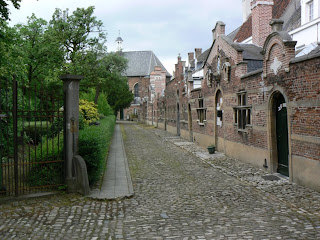
Small Beguinage,
Ghent, Belgium
For nearly one thousand years, nearly all monastics basically withdrew from the regular affairs of the world. Some of this was good (see last blog), yet it was lacking. Vibrant faith needs to reach out to those around us in both caring and sharing. We need to care for others, especially those in greatest need, in practical ways. We also need to share Jesus’ love with everyone around us.
Genuine believers in the Middle Ages recognized the need to care and share, so the picture of monasticism began to changed during the 1100s. A new monasticism emerged, engaging in the world to help the sick and poor, as well as evangelize both countryside and city. This new monastic movement was committed to an evangelical—i.e., gospel—lifestyle.
Evangelical Lifestyle
First, instead of staying behind the walls of a monastery, these men and women traveled about the countryside sharing the gospel. They tried to follow Jesus’ command to his disciples (12 and then 72) in Luke 9 and 10. Because Jesus gave these instructions to his apostles (“sent ones”), this lifestyle was often called the vita apostolica—apostolic life.
=>Traveling two-by-two
=>Preaching the gospel in the local dialect
=>Often translating a portion/book of the Bible into the local dialect so people had access to God’s Word.
Second, following Luke 9 and 10, they lived simple lives. Owning no extra clothes and taking no food with them, they lived off of what people in the villages supplied. They were called mendicants (those who beg for a living). Today we would call them missionaries who raise their own funds!
=>Lives of simplicity/poverty
=>Living from donations
Third, they did practical ministry among those in need. They nursed the sick and tended the lepers. They provided food to the poor, often going hungry themselves because they passed on the food that had been given to them.
=>Care for the poor
=>Tending the sick, leprous and dying
Fourth, the new monasticism often included laypeople. Some—like the Beguines and Humiliati—formed their own lay communities. Others lived at home with their families and joined in the ministry as they were able.
This was a new monasticism of the time. Traditional monks did not care for it. They could not understand being out among people all day—ministering to the poor, nursing the sick and preaching the gospel. But opposition did not slow down the new monastics. They were radically committed to Christ and wanted to serve their Lord by serving those around them.
The Beguines (discussed on this blogsite) were part of the New Monastic Movement of the Middle Ages. Other groups like the Dominicans, the Humiliati and the Waldensians were also part the vita apostolica. The best-known of these new monastics were St. Francis of Assisi and his followers, who brought the gospel to all of Europe and began a mission movement around the world! Some of my upcoming blogs will be dedicated to his phenomenal movement.
2010 © Glenn E. Myers





